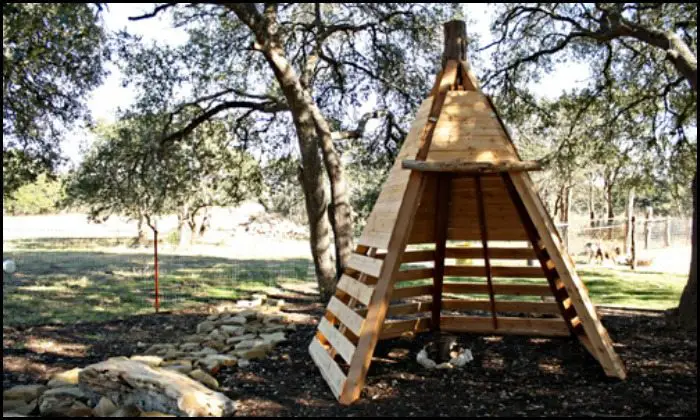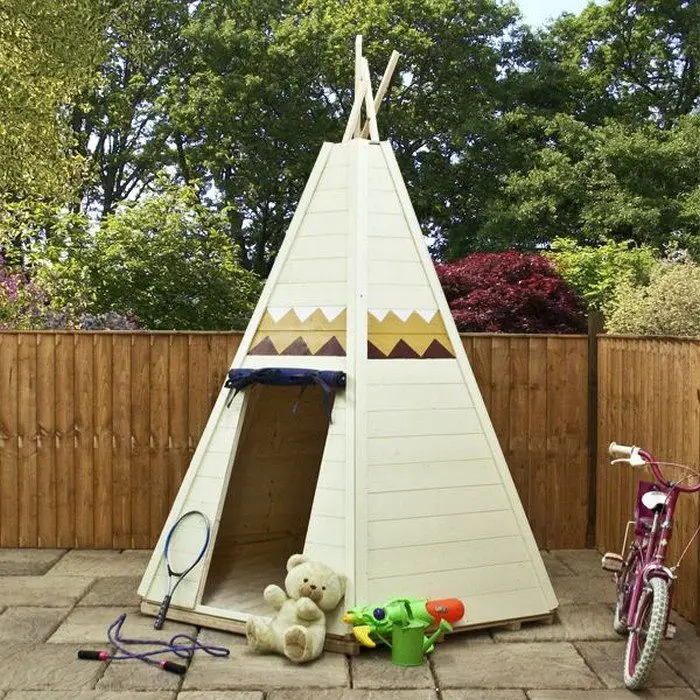
What kid wouldn’t want to have their own playhouse? Now if you’re looking for something different for your little ones, why not build them a wooden teepee playhouse?
A wooden DIY outdoor teepee for kids is lightweight, easy to build, and durable. It’s perfect for outdoor play in your backyard! It provides great shade and ventilation for the kids during the day, and you won’t have to worry about it blowing away when it’s windy.

What’s also nice about this DIY project is that you can make yours as uniquely as you want it to be. Simply make some minor changes from your inspiration and it will already look very different!
The size of course would depend on the space that you have. But if space is not a concern, then why not build a large one? This way your kids can still use the wooden teepee tent for some other purpose such as a reading nook when they’ve grown and past the role-playing stage!
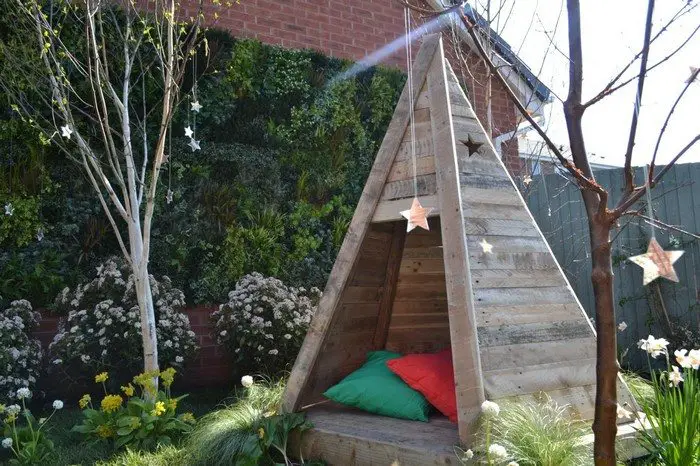
Make sure to use cedar timber for this project especially if you are going to build it for the outdoors. Cedar wood is naturally resistant to rot and decay. It’s also one of the safest materials you can use for kids’ projects.
Is this going to be your next project for your little ones?
Contents
How to Craft a Delightful DIY Outdoor Teepee Tent for Kids
This project will surely bring joy and excitement to young hearts as they have a cozy hideaway. In this step-by-step guide, explore the art of woodworking and discover how to create a charming teepee tent that sparks endless adventures and cherished memories.
Now, gather all the necessary materials and tools to get started, and follow our guide on how to make a teepee.
Materials & Tools
- 5 pcs 4x4x10 Cedar Fence Posts
- 4 pcs 2x2x10 Cedar
- 2 pcs 2x4x10 Cedar
- 30-40 pcs 6′ Cedar Fence Pickets
- 1 Stump (20″ circumference)
- 15 pcs 6″ Hex Screws
- 2-1/2″ Decking Screws (for base)
- 1-1/4″ Decking Screws (for siding)
- Measuring Tape
- Miter Saw
- Square
- Cordless Drill
Click on any image to start lightbox display. Use your Esc key to close the lightbox ![]()
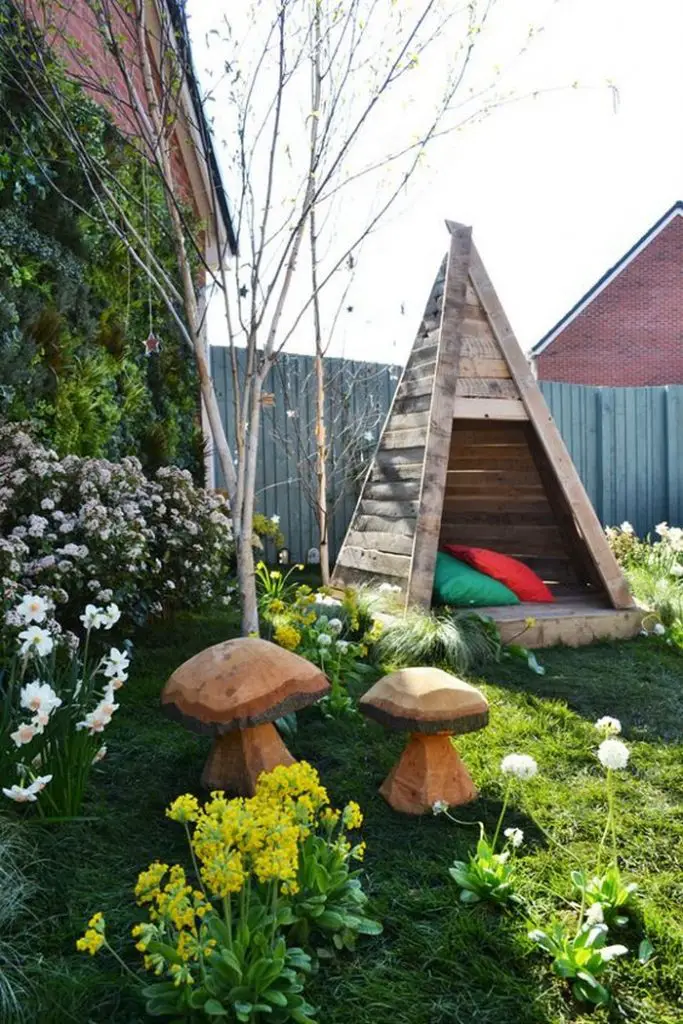
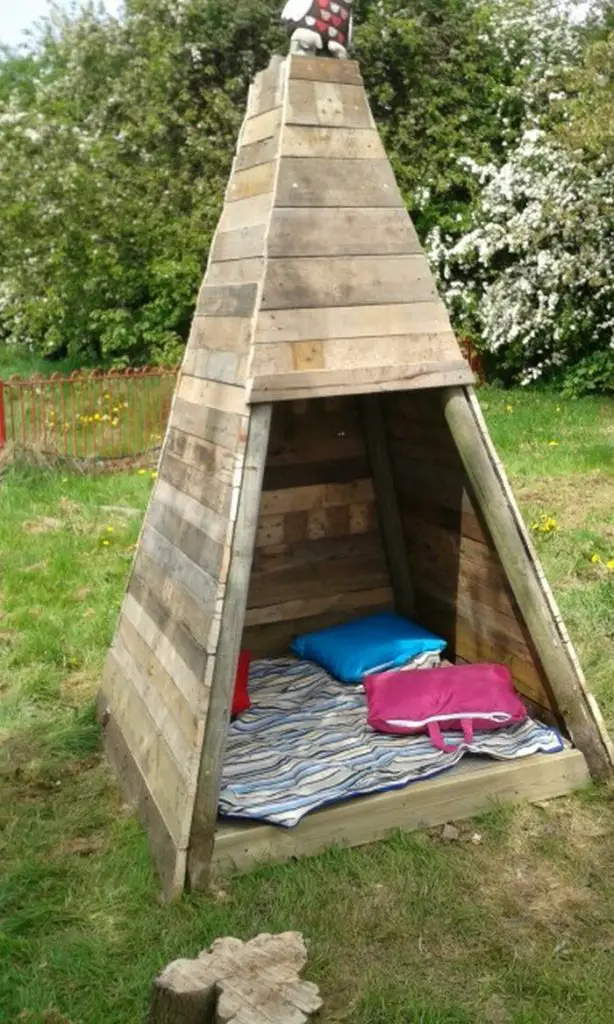
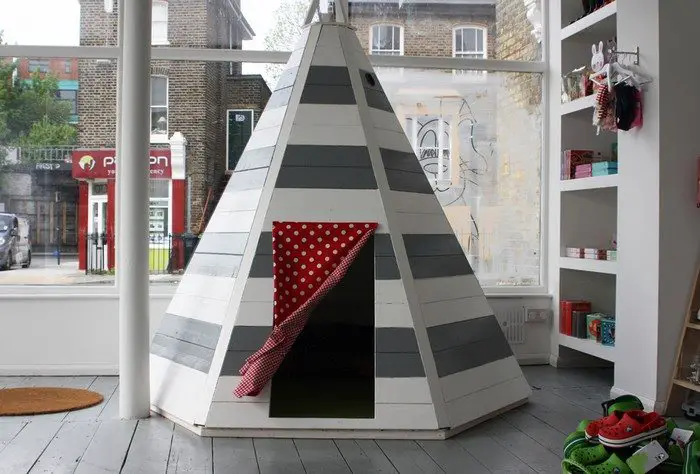
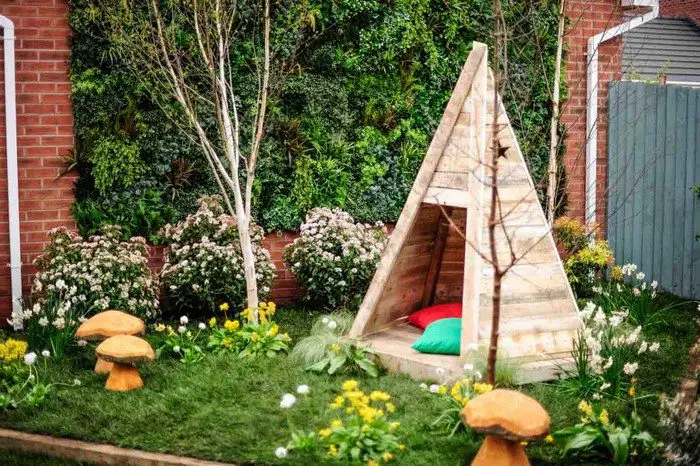
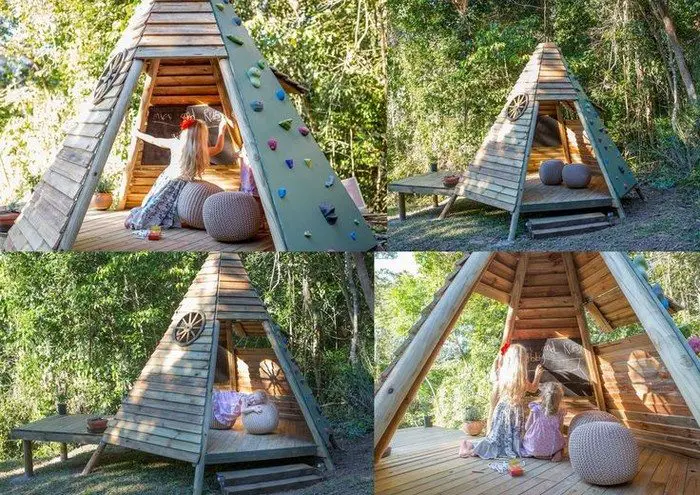


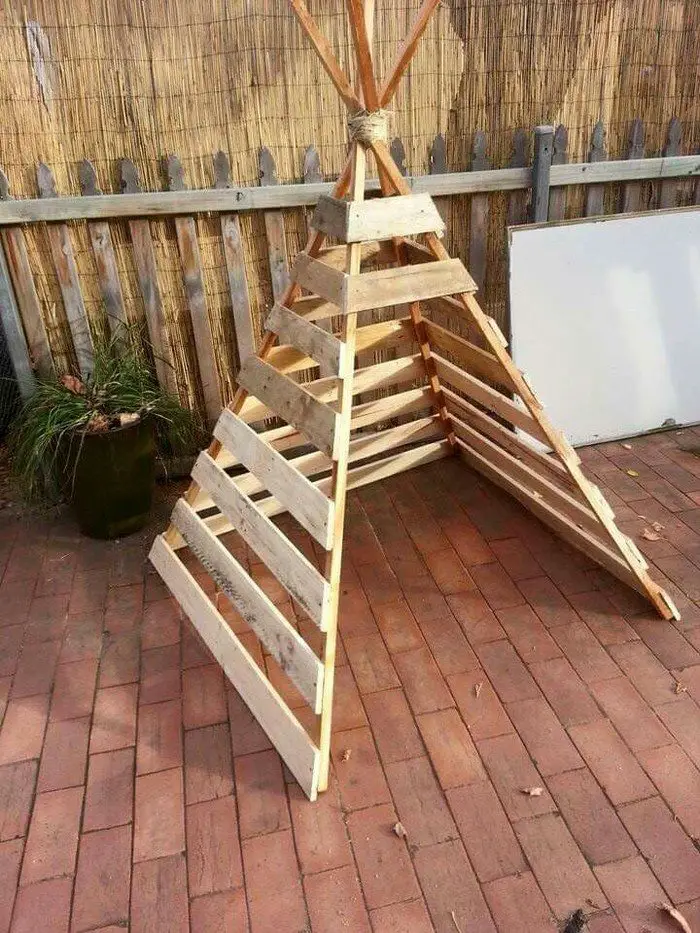
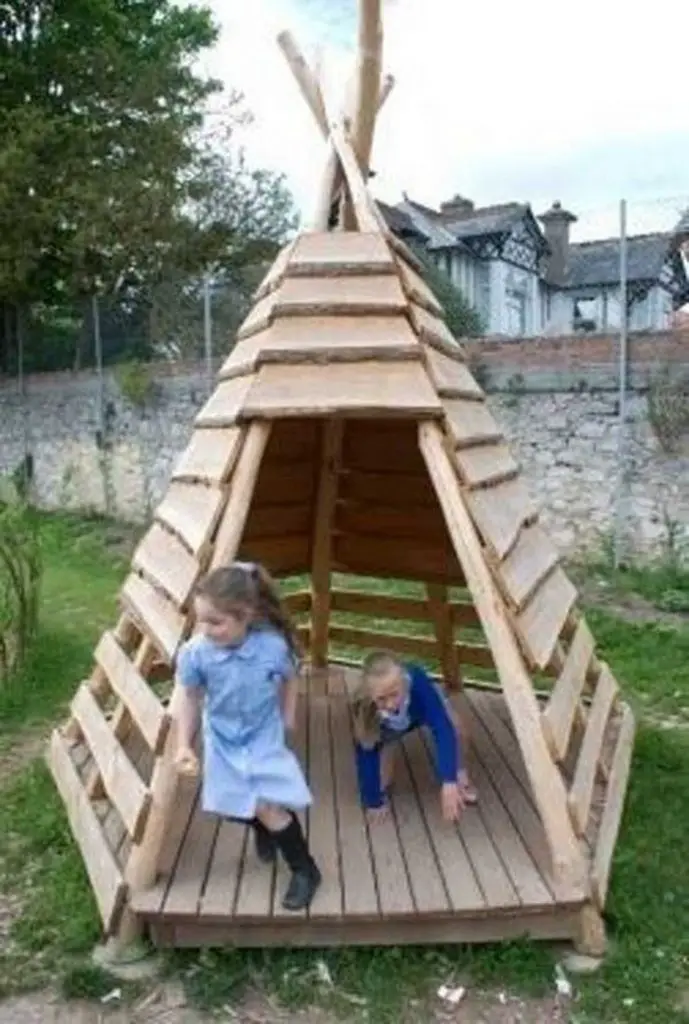
Steps
Step 1: Prepare the Site
Choose a flat and clear area in your backyard. Place the stump in the center; this will be the teepee’s base.
Step 2: Cut the Cedar Posts
Trim one end of each 4x4x10 cedar post using the miter saw to a sharp point. This will help when inserting them into the ground and create the teepee shape.
Step 3: Arrange the Base
Stand the 4×4 posts around the stump, forming a circle with about a 5-foot diameter. Use the measuring tape to ensure even spacing. The pointed ends should face upwards.
Step 4: Secure the Base
Drill two 2-1/2″ decking screws into the bottom of each post into the stump to secure them in place. This forms a stable base for your teepee.
Step 5: Create the Frame
- Top Frame: Take the 2x2x10 cedars and lay them across the top of the posts, forming a hexagonal frame. Secure each end to the top of the posts with 6″ hex screws.
- Support Beams: Use the 2x4x10 cedars for additional support beams halfway up the structure. Attach these horizontally between the posts with decking screws.
Step 6: Add the Siding
- Begin attaching the cedar fence pickets vertically to the frame, starting from the bottom and working your way up. Overlap each picket slightly to ensure no gaps.
- Secure each picket with 1-1/4″ decking screws to the horizontal support beams and the base posts.
Step 7: Trim the Doorway
Choose a side for the entrance. Use the miter saw to cut a doorway by removing part of two pickets and trimming the adjacent pickets to create a welcoming entrance.
Step 8: Finishing Touches
- Sand any rough edges around the doorway and the base of the teepee to prevent splinters.
- You can add a personalized touch by staining or painting the wood, but ensure the products are safe and suitable for outdoor use.
Extra Tips

Here are some extra tips to make the process of building an enjoyable wooden DIY outdoor teepee tent even smoother:
1. Select Child-Friendly Materials: When building a DIY outdoor teepee , the choice of materials is crucial for ensuring the safety and health of children. Look for wood that hasn’t been treated with harmful chemicals, which could be hazardous if kids come into contact with them or if they are inhaled. Cedar is a great choice because it’s naturally rot-resistant and doesn’t require chemical treatment to withstand the elements.
2. Create a Cozy Interior: Transforming the interior of the teepee tent into a snug retreat makes it an inviting place for children. Start by laying down a thick, soft rug or blanket that will cushion the floor and keep it warm. Add several plush pillows and fluffy cushions for seating and lounging, making sure they are made of child-friendly fabrics that are easy to clean and free from small parts or hazardous materials. Consider introducing a few throw blankets for cooler days or for creating a lap cocoon while reading or resting.
3. Ensure Proper Ventilation: Good ventilation is essential for keeping the teepee tent’s interior fresh and comfortable, especially during warmer months or when the tent is in direct sunlight. One way to achieve this is by designing the teepee with a small vent at the top. You can leave an intentional gap in the structure or install a breathable mesh fabric. This allows hot air to escape, maintaining a cooler temperature inside.
4. Outdoor Waterproofing (Optional): If the teepee tent is intended for outdoor use, especially in areas prone to rain or damp conditions, waterproofing the wood is a smart step to prolong its life and maintain its appearance. Apply a waterproof sealer to all wooden components of the teepee tent. This sealer should be non-toxic and safe for use around children. It protects against moisture, preventing wood rot and mold growth.
5. Stability and Safety: Double-check that the teepee tent structure is stable and securely anchored to prevent accidents during playtime. Then, always supervise kids while they are using the teepee tent to ensure their safety.
6. Personalize with Decorations: Encourage creativity by involving the kids in decorating the teepee tent. Provide art supplies such as fabric paints, colourful ribbons, and stickers, allowing them to add their personal touch and make the teepee uniquely theirs.
7. Incorporate Fairy Lights: For an extra touch of magic, string fairy lights inside the teepee tent to create a whimsical and enchanting atmosphere. The soft glow will add a magical touch to their playtime adventures.
8. Use Removable Fabric Covers: If you want to change the look of the teepee tent or wash the covers easily, consider using removable fabric covers for the wooden frame. This way, you can switch up the design whenever you like.
9. Encourage Playtime Themes: Enhance the imaginative play experience by incorporating themed elements inside the teepee. You can add toy camping gear, stuffed animals, or themed props to spark their creativity and make playtime even more enjoyable.
10. Create Memories: Capture the process of building the teepee tent and the kids’ joyful moments inside it through photos and videos. These memories will be cherished for years to come, reflecting the special bond shared during this creative project.
With these extra tips, building an enjoyable wooden teepee tent for kids will not only be a fun and engaging experience but also a cherished memory in itself. Watch as their faces light up with excitement and joy as they enter their personalized playhouse, where limitless adventures await!
Educational Activities to Enhance Play
Playing in a wooden teepee tent isn’t just fun; it’s a fantastic opportunity for learning too. Here are some educational activities that can transform playtime in your DIY outdoor teepee into an enriching experience. These ideas will stimulate young minds and make the wooden teepee tent a hub of creativity and discovery.
Storytelling Adventures
Transform the wooden teepee tent into an enchanting storytelling hub. Make the interior cozy with cushions, blankets, and soft lighting. Bring a selection of books that cater to your child’s interests and reading level. Encourage them to read aloud, enhancing their literacy and public speaking skills.
Take turns reading to each other to make it interactive. You can also create a story together by starting with a simple sentence and taking turns to add to it. This boosts their creativity and helps with their narrative skills and imagination. The act of creating stories in such a magical setting as a wooden teepee tent makes reading and storytelling an adventure they’ll look forward to.
Nature Crafts
The DIY outdoor teepee is a perfect backdrop for engaging with the natural world. Encourage kids to gather natural materials like leaves, twigs, rocks, and flowers from around your garden or nearby parks (ensuring it’s safe and permitted to take these items). Inside the tent, lay out these treasures and provide materials like glue, paper, and markers. Kids can create nature collages, decorate stones, or even build mini fairy houses.
This activity fosters a deep appreciation for the natural world and teaches them about different types of plants and animals, their environments, and the importance of preserving natural beauty. It’s a hands-on way to connect with nature and learn about the world outside their DIY outdoor teepee.
Stargazing Nights
On nights when the sky is clear, the wooden teepee tent transforms into a cozy observatory. Equip the tent with a portable telescope and a guide to the stars and planets. Teach kids how to identify constellations, planets, and even satellites. Discuss the myths and stories associated with constellations to blend astronomy with ancient storytelling.
You can also introduce basic physics concepts by explaining how gravity works or why planets orbit the sun. This not only makes for a magical evening but sparks an interest in science and the vast universe. Stargazing from the comfort of a wooden teepee tent can turn a simple night into an unforgettable educational experience, showing kids the vastness of the universe and their place within it.
Educational Games
Transform the wooden teepee tent into a lively game room where learning and fun meet. Start by selecting a range of games that challenge the mind and spark joy. Puzzles, for instance, can range from simple shapes for younger kids to complex jigsaws for older ones, helping improve spatial awareness and patience.
Memory games from cards or objects around the tent bolster cognitive skills and focus. For a math adventure, create simple math challenges or use board games that require counting and strategy. These games make learning enjoyable and encourage critical thinking and problem-solving skills within the playful confines of the wooden teepee tent. These activities foster a love for learning, teamwork, and healthy competition.
Cultural Exploration
The wooden teepee tent becomes a portal to the world, introducing kids to the rich tapestry of global cultures. Start by selecting a country or culture to explore each time. Dressing up in traditional clothing and learning simple phrases in the native language of that culture brings an immersive experience.
Create a playlist of traditional music and prepare simple dishes or snacks typical of the region. Discuss the significance of certain customs, holidays, and everyday life, using books or online resources for an authentic understanding. This journey around the world within the DIY outdoor teepee cultivates an appreciation for diversity, broadens their worldview, and teaches respect for different ways of life.
Science Experiments
The wooden teepee tent can easily be transformed into a captivating science lab, where everyday items become tools for discovery. Begin with plant biology by planting seeds in clear containers, allowing kids to observe germination and root development over time. Discuss the life cycle of plants and the importance of sunlight and water.
Physics experiments with shadows can be fascinating; using toys or objects to create shadows inside the tent teaches basic principles of light and shadow. Simple chemical reactions, like mixing baking soda and vinegar, show the exciting effects of combining different substances. These safe and engaging experiments within the wooden teepee tent demystify science and ignite a curiosity about how the world works, encouraging young scientists to question, hypothesize, and explore.
Art Studio
The wooden teepee tent can become a vibrant art studio, a place where imagination takes physical form. Stock the tent with art supplies like paper, canvases, brushes, paints, and clay.
Encourage children to look outside for inspiration, whether it’s the sky’s color, the leaves’ shapes, or the tree bark’s texture. They can then express these observations through drawing, painting, or sculpting. This allows them to appreciate the beauty around them and improves their observational skills, creativity, and fine motor skills. By turning the DIY outdoor teepee into an art studio, kids learn that art is not just about creating; it’s about expressing and seeing the world in vibrant colors and textures.
Music and Rhythm
Inside the wooden teepee tent, music can become a magical experience. Introducing musical instruments into this space allows children to explore sounds, rhythms, and melodies. You can provide a mix of real instruments, like a keyboard, drums, or a ukulele, and homemade instruments from recycled materials.
The instruments could include shakers from coffee-filled bottles or a drum set from various-sized containers. Encouraging kids to experiment with these instruments helps them understand the basics of music theory, such as rhythm and pitch. Additionally, sharing music from different cultures broadens their appreciation and understanding of the world, enhancing their auditory skills and fostering a global musical perspective.
Environmental Education
The wooden teepee tent is an ideal setting for environmental education and sustainability lessons. Within this natural backdrop, discuss the importance of caring for the planet through recycling, composting, and conserving water. Practical activities can bring these concepts to life, such as setting up a recycling center in the tent, starting a compost bin for garden waste, or planting a small garden with drought-resistant plants.
These activities teach children about the environment and show them how they can make a difference in their daily lives. By learning about sustainability in the DIY outdoor teepee tent, kids develop a deeper connection to the environment and a strong responsibility to protect and preserve it for future generations.
Little Dreamers’ Haven!
Within this guide, you have explored the three fundamental aspects that ensure constructing a wooden teepee tent for kids is a seamless and enjoyable experience. You have gained insights into the essential materials and tools needed to bring this enchanting project to life, and a detailed list has been provided to ensure a smooth and well-prepared construction process. Additionally, valuable tips have been shared to ensure the success of your project, making this creative endeavour all the more fulfilling and rewarding.
From assembling the wooden frame to securing the fabric covers, the clear and concise directions will make the construction process a breeze, even for those new to woodworking.
By adding fairy lights, the interior of the teepee will be bathed in a soft, radiant glow, creating a whimsical ambience that will fill their eyes with wonder. Encouraging imaginative play, themed elements such as toy camping gear, stuffed animals, and other props can be incorporated, igniting the spark for countless adventures.
With every giggle and smile, this teepee tent will transform into a cherished gateway to boundless experiences and treasured memories. So, embark on the journey of building an enjoyable wooden teepee tent. Ignite the flames of imagination and give the little ones a magical haven of play and wonder.
If you want more fun projects for your kids, check out our DIY water wall next!
FAQ: DIY Outdoor Teepee
- What are some ways to decorate the outside of a teepee?
- Decorating the outside of a teepee offers a chance to combine creativity with cultural appreciation. Incorporate traditional patterns to teach about Native American history, encouraging kids to interpret these designs with paints or fabric markers.
- Add a natural touch with leaves, feathers, or small branches for an earthy, bohemian look, or brighten the structure with vibrant eco-friendly paints and symbols. Enhance the design further with colorful fabrics, ribbons, or LED lights, making the teepee a unique and inviting space. These creative touches transform a simple teepee into a meaningful and artistic centerpiece.
- How can you secure the teepee cloth to the poles?
- To secure the teepee cloth to the poles, start by positioning the cloth at the back of the structure, ensuring the front opening is properly aligned. Attach the top center of the cloth about a foot from the pole tips, focusing on this connection point first for stability.
- If you’re working alone or lack a tall helper, temporarily remove the rear pole for easier access. Use duct tape to create a loop or ring as a temporary fastener, securing the cloth to the pole while keeping it adjustable. This method provides stability and flexibility until the final adjustments are complete.
- What is the purpose of building a teepee in terms of education and play?
- Playing in a wooden teepee tent combines fun with educational opportunities. This project introduces children to the traditional dwellings of Native American plains tribes, offering insights into historical building techniques and cultural significance.
- Engage kids with activities like storytelling, where they use the teepee as a backdrop for tribal legends, or explore the engineering behind traditional teepee construction. Encourage creativity by letting them decorate the tent with symbols inspired by tribal art. This fusion of play and learning makes the wooden teepee tent a space for both cultural discovery and imaginative expression.
- What is the intended dual purpose of the teepee?
- The teepee is designed to be both an educational resource and a playful space, providing children with a place to learn and enjoy themselves simultaneously.
- What basic skills or knowledge about construction are imparted?
- The project introduces children to fundamental concepts of how a teepee is constructed and assembled, offering insights into basic building techniques.
- What cultural or historical context is provided by the teepee?
- The teepee serves as an educational tool to teach children about the traditional dwellings used by certain Native American tribes from the plains, highlighting its cultural and historical significance.
- Why might building a teepee be a respectful learning experience?
- Building a teepee can be a respectful learning experience as it offers insight into the resourcefulness and culture of Native American tribes. When approached with sensitivity and respect, it can serve as an educational tool to foster appreciation and understanding of indigenous communities and their innovations.
- What makes teepees an ingenious type of housing?
- Teepees are considered ingenious due to their simplicity, ease of construction, and portability. Their design efficiently manages ventilation and can withstand various weather conditions, making them an effective form of housing in the plains.
- How is a teepee constructed and assembled?
- A teepee is constructed using a framework of poles arranged in a conical shape, covered by a durable material, often animal hides. This design allows for easy assembly and disassembly, making it highly portable and suitable for nomadic lifestyles without requiring nails or sawing.
- How can cultural elements be integrated into the decoration process?
- Introduce children to Native American designs as inspiration for their decorations, allowing them to learn about and incorporate meaningful symbols into their creative expression.
- What hands-on activities can children participate in during the building process?
- Children can be involved in preparing the branches by slightly tapering the ends. This can be done by rubbing them on a rough surface like a sidewalk or using sandpaper, offering them a chance to contribute actively.
- How can children be involved in the material collection process?
- Involve children in gathering thin branches, making it a fun scavenger hunt. This hands-on task can keep them engaged and excited about the project.
- How can you involve children in the process of building a teepee?
- Involving kids in building a teepee tent turns the project into a fun and educational adventure. Start by collecting sturdy branches outdoors, letting kids explore nature and assist with tasks like sanding the ends to develop fine motor skills.
- Incorporate a learning moment by introducing traditional American Indian patterns and their cultural significance, blending history with creativity. Encourage children to personalize the teepee with fabric paints, ribbons, or stickers, allowing them to express individuality and pride in their creation. This hands-on project combines exploration, education, and creativity, leaving kids with a memorable and enriching experience.

